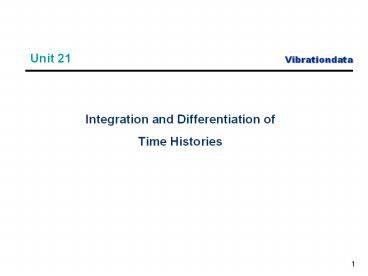Integration and Differentiation of Time Histories - PowerPoint PPT Presentation
Title:
Integration and Differentiation of Time Histories
Description:
Unit 21 Integration and Differentiation of Time Histories * * Accelerometer Mechanical vibration is usually characterized in terms of acceleration The main reason is ... – PowerPoint PPT presentation
Number of Views:162
Avg rating:3.0/5.0
Title: Integration and Differentiation of Time Histories
1
Unit 21
- Integration and Differentiation of Time
Histories
2
Accelerometer
- Mechanical vibration is usually characterized in
terms of acceleration - The main reason is that acceleration is easier to
measure than velocity or displacement - Acceleration can be measured with a
piezoelectric, piezoresistive or variable
capacitance accelerometer
3
Velocity Criteria
- Hunt, Gaberson, Bateman, et al, have published
papers showing that dynamic stress is directly
proportional to modal velocity (future webinar) - A peak velocity of 50 in/sec is sometimes
considered as the shock severity threshold for
military components - Allowable building floor vibration limits are
typically lt 2.0 in/sec - Colin Gordon has established a generic vibration
criteria for building floor vibration in terms of
velocity (see ISO Generic Vibration Criteria for
Vibration-Sensitive Equipment)
4
Velocity Sensor
- Velocity measurements require a Doppler laser or
a geophone - The laser is expensive and requires a direct line
of sight - The geophone is bulky and is intended for
seismology measurements
5
Geophone
6
Laser Vibrometer
Advantage No mass loading effect from laser on
object. Disadvantage Laser system actually
measures relative velocity between laser source
and object, so laser source must be kept still.
A single point laser vibrometer is used to
compare the vibration of two similar guitars
7
Scanning Laser Vibrometer
- A Scanning Laser Vibrometer measurement shows the
velocity profile of a vibrating turbine blade - The measurement grid has been tailored to match
the specific shape of the blade
8
Displacement Sensor
- Dynamic displacement can be measured by a linear
variable displacement transducer (LVDT) - The frequency response is only suited for
low-frequency measurements
LVDTs used to measure traffic-induced vibration
on underside of bridge
9
Old School Analog Method for Measuring Velocity
Displacement
- Measure vibration with charge mode piezoelectric
accelerometer - Analog signal goes through Bruel Kjaer 2635
signal conditioner - Select acceleration, velocity or displacement
output with this knob - Analog integration double integration applied
for velocity displacement, respectively - Highpass filtering needed to prevent spurious
offsets, drifts, etc. - Minimum highpass filtering frequencies
- 0.2 Hz for acceleration
- 1 Hz for velocity displacement
10
Typical Building Vibration Limits
Transportation Research Board Building Maximum Structure Vibration Criteria Transportation Research Board Building Maximum Structure Vibration Criteria Transportation Research Board Building Maximum Structure Vibration Criteria
Limiting Peak Particle Velocity Limiting Peak Particle Velocity
Structure and Condition (in/sec) (cm/sec)
Historic buildings, Certain other old buildings 0.5 1.3
Residential structures 0.5 1.3
New residential structures 1.0 2.5
Industrial buildings 2.0 5.1
Bridges 2.0 5.1
11
Hyatt Regency Hotel, Phoenix, Arizona
Typical Elevator Recommended Limits
Parameter Limit
acceleration/ deceleration lt 1.0 - 1.5 m/sec2
Speed lt 7.0 m/sec
Jerk rates lt 2.5 m/sec3
Sound lt 50 dBa
Ear-pressure change lt 2000 Pa
Fast elevator ride from ground floor to top
restaurant!
12
Accelerometer Measurement
Integrated Velocity
13
Hyatt Regency Elevator Accelerometer Measurement
Differentiated Jerk
14
Integration, Trapezoidal Rule
The integration of a time history is carried out
on a running sum basis. Let the
acceleration time history be represented by a1,
a2, a3, . . . , an. The velocity time history
is calculated as follows.
15
Differentiate, Matlab Function
functionvdifferentiate_function(y,dt) ddt12.
dt nlength(y) v(1)( -y(3)4.y(2)-3.y(1)
)/(2.dt) v(2)( -y(4)4.y(3)-3.y(2)
)/(2.dt) v(3(n-2))(-y(5n)8y(4(n-1))-8y(2
(n-3))y(1(n-4)))/ddt v(n-1)( y(n-1)-y(n-3)
)/(2.dt) v(n) ( y(n-1)-y(n-2) )/dt
y input amplitude v output amplitude dt
time step
16
Sine Example
Generate sine function Amp 1 Dur 10
sec Freq 1 Hz Sample Rate 40 Hz (assume amp
unit G ) Save as sine_accel.txt
17
Integrate from Acceleration to Velocity to
Displacement
Time History Analysis gt Integrate
Differentiate gt Double Integrate
18
Integrate from Acceleration to Velocity to
Displacement
Mean Velocity 61 in/sec
19
Integrate from Acceleration to Velocity to
Displacement with Mean Removal
20
Integrate from Acceleration to Velocity to
Displacement with Mean Removal
Save displacement as sine_disp.txt
21
Differentiate from Displacement to Velocity
Time History Analysis gt Integrate
Differentiate gt Differentiate
Input File sine_disp.txt
22
Review Exercise, Sine Amplitude
Agrees with integration differentiation results
on previous slides
Miscellaneous gt Sine Amplitude Conversion
23
Double Integrate Pyrotechnic Shock Ground Test
Data
Filename pyro_test.txt
24
Experiment with Different Trend Removal Options
1st order trend removal used on all signal for
this example































